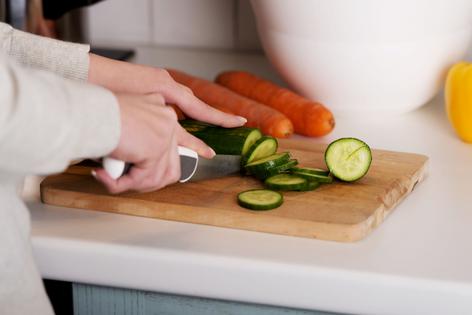Environmental Nutrition: Top culinary tips for health
If you stay out of the kitchen, chances are your diet -- and health -- will suffer. Several studies show that dining out often is linked with higher body weight, body fat and obesity. What's the antidote? It's easy: wholesome, home-cooked meals that feature fish, poultry, low-fat dairy, legumes, whole grains, vegetables and fruits. After all, it's much easier to produce meals with more healthful ingredients and cooking techniques when you do the cooking yourself.
Make a pact to do more home cooking of delicious, health-promoting meals by improving your culinary skills. Chef Brendan Walsh, dean of culinary arts at the Culinary Institute of America, shared some of his essential strategies for home cooking at the Healthy Kitchens, Healthy Lives Conference held in St. Helena, California, in March 2014:
--Get organized. Chefs call it "mis-en-place," which means "putting it in place." In order to be a good cook, you have to set yourself up and be organized. Plan your weekly menu with a shopping list, so that you have everything you need on hand. When you start cooking, assemble all of your ingredients and tools, and clean up as you go.
--Buy great ingredients. Prioritize high quality ingredients -- the cornerstone of delicious, healthy food. Select fresh vegetables in season and at their peak, look for trusted brands, and be choosy when selecting lean meats, poultry and fish.
--Store your items well. One firm kitchen rule, according to Walsh, is to limit foods' exposure to air and water to help foods stay fresh longer. Keep foods covered, out of sunlight, and at an appropriate temperature -- below 40 for perishable items. If you're freezing leftovers, place them in airtight containers and label with the date.
--Prep your foods wisely. You can save a great deal of time during preparation, which can be your biggest challenge in cooking. Walsh suggests prepping ahead when possible, such as slicing all of your onions and carrots for the next few days, or cooking up a whole pound of beans and using them in a few dishes during the week.
Cooking skills on the decline
Unfortunately, we're losing our cooking know-how, thanks in part to the lack of home economics courses taught in schools and a rise in convenience foods such as frozen meals and prepared entrees. According to some of the findings reported in a 2010 Harris Interactive poll of 2,503 adults, 14 percent said they don't enjoy cooking, and 7 percent said they don't cook at all. Only 41 percent said they prepare meals at home five or more times per week.
Chef's favorite kitchen equipment
Chef Brandon Walsh recommends the following essential kitchen tools.
Basic pots and pans:
--Saute pan. A 5-quart saute pan (nonstick is a bonus) with a cover can be used for sauteing vegetables, side dishes and entrees.
--Roasting pan with rack. This basic 16-inch pan allows you to roast vegetables, casseroles, side dishes and meat; the rack allows you to circulate air around the item while cooking.
--Large stock pot. An 8-quart stockpot is perfect for boiling pasta and grains, and simmering soups, pasta sauce and bean dishes.
--Saucepan. A 3-quart saucepan is ideal for cooking up smaller batches of grains, beans and sauces.
Bonus cooking equipment:
--Dutch oven. A Dutch oven is a handy covered dish that can go from stovetop to oven, and is perfect for slow-cooked meals.
--Pressure cooker. Today's modern pressure cookers are easy to use and allow you to cook whole grains and beans in minutes.
--Rice cooker. This easy device allows you to cook rice as well as whole grains like faro and quinoa with just a push of a button -- no stirring required.
Cutlery:
When chefs were surveyed regarding their favorite four pieces of kitchen cutlery, they listed these basics.
--French knife. This basic, all-purpose knife (about 8 inches long) can be used for chopping meats, vegetables and fruits.
--Paring knife. A 3 1/2-inch paring knife is an "extension of your hand" and great for slicing small fruits and vegetables.
--Serrated knife. A classic 8-inch serrated knife can slice through softer foods such as tomatoes and bread.
--Sharpening steel. Use this tool frequently to sharpen your knives' edges for optimal cutting.
Environmental Nutrition's Pantry List
Keep these shelf-stable ingredients on hand at all times to turn out wholesome meals in minutes.
--Canned vegetables, sodium free if possible (tomatoes, artichokes, corn)
--Dried beans, peas, lentils
--Dried fruits (raisins, cranberries, apricots)
--Extra virgin olive oil
--Nuts (almonds, walnuts, pistachios)
--Pasta, whole grain
--Seeds (sunflower, chia, hemp)
--Spices and herbs (cinnamon, oregano, black pepper)
--Whole grains (faro, brown rice, quinoa)
(Reprinted with permission from Environmental Nutrition, a monthly publication of Belvoir Media Group, LLC. 800-829-5384. www.EnvironmentalNutrition.com.)







